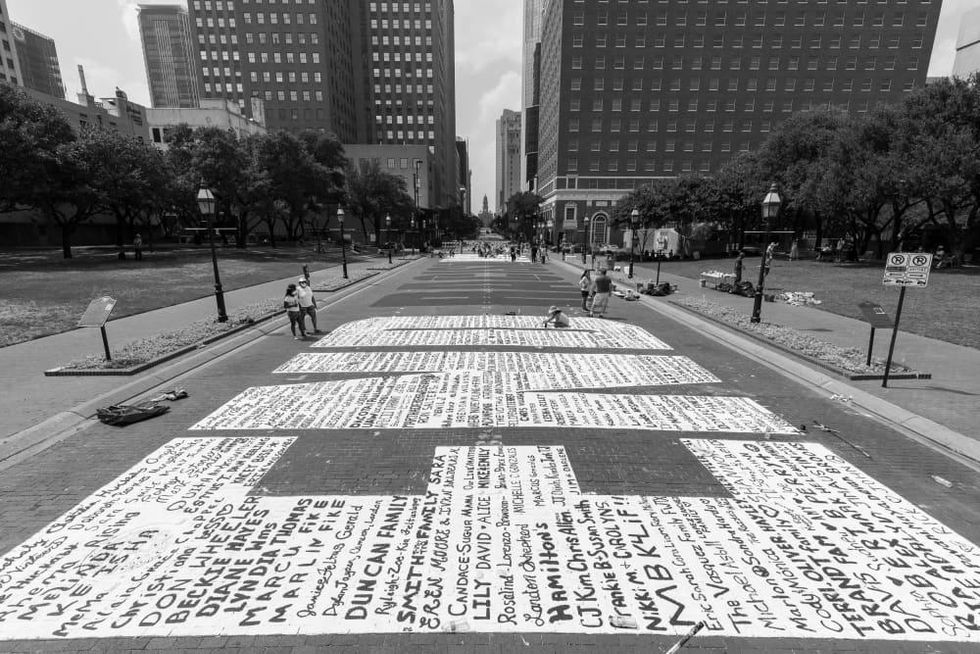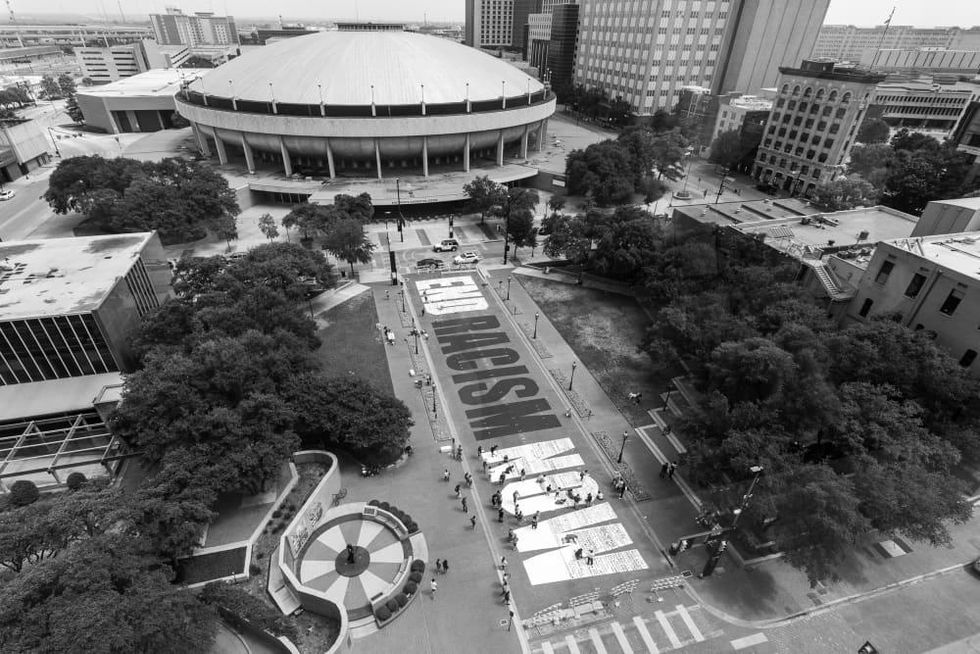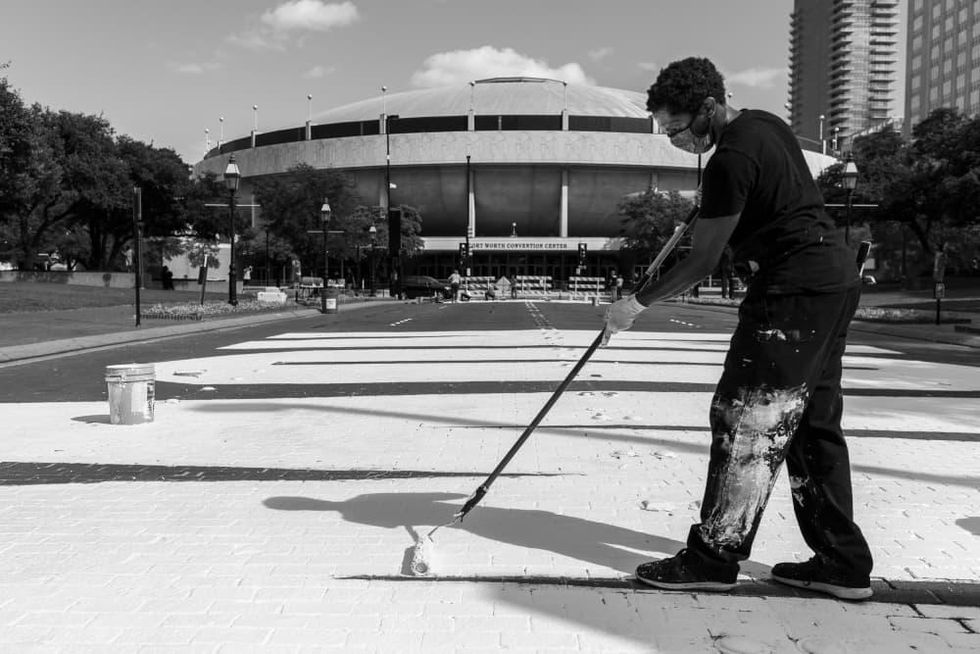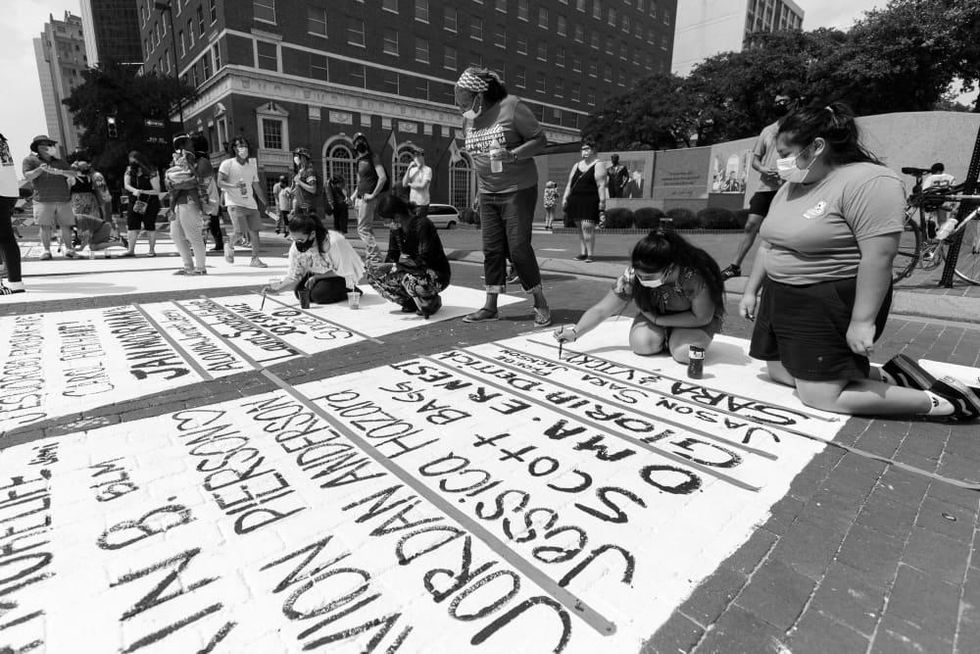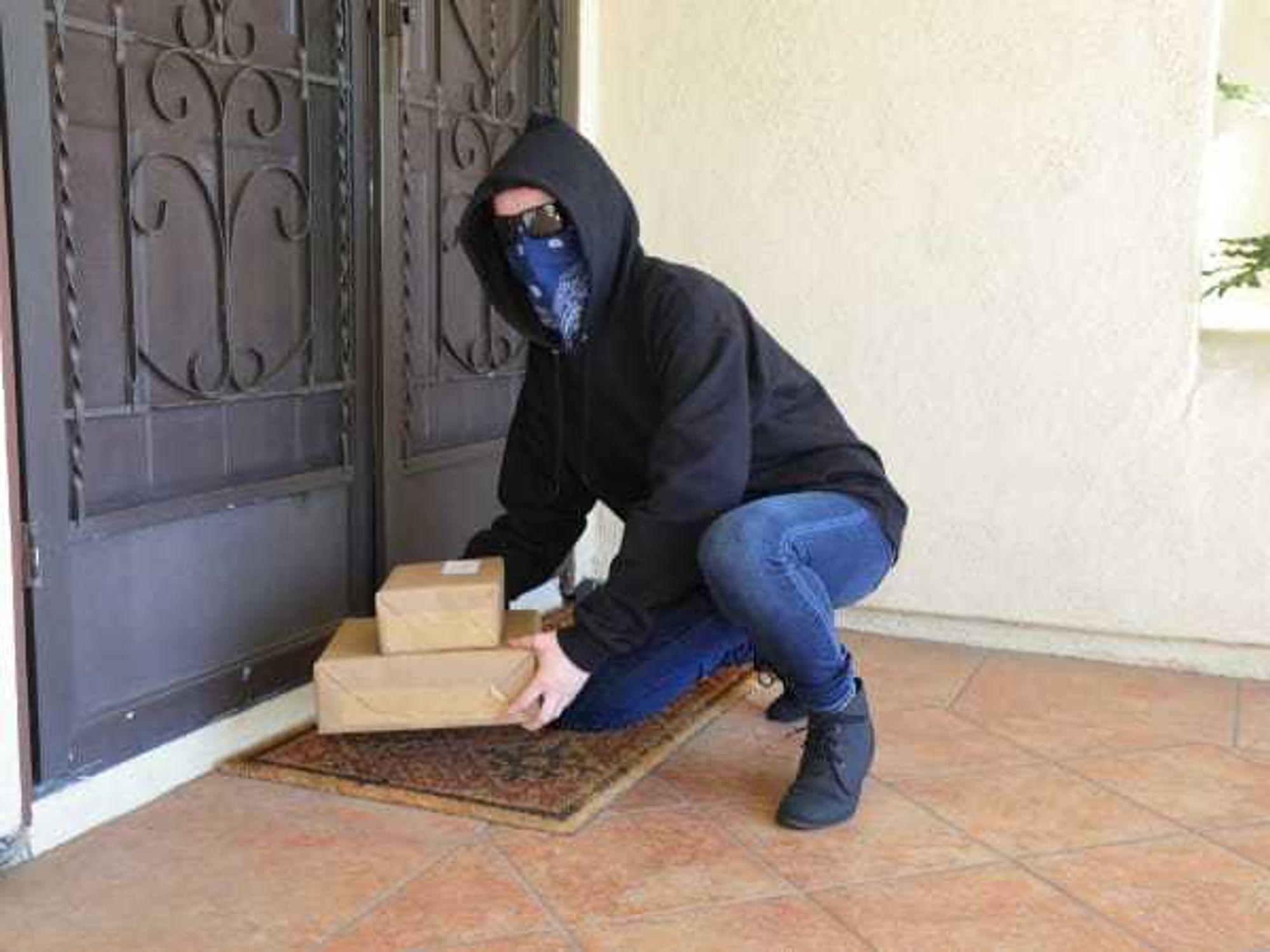End Racism Now
Fort Worth takes anti-racism message to the street with inspiring new downtown mural
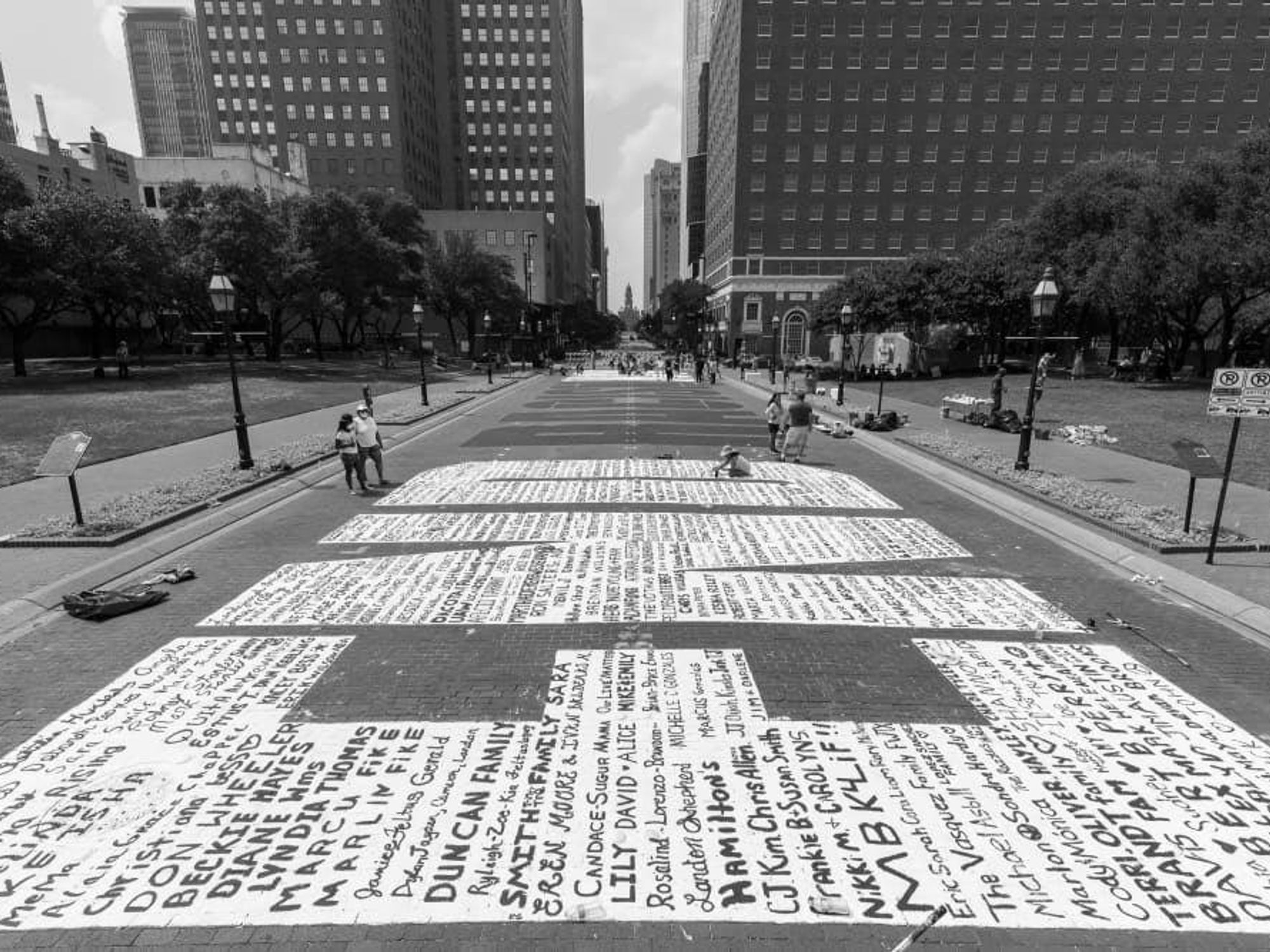
His fist full of paintbrushes, Sedrick Huckaby made his way through a scattered crowd of about 75 people, stopping at a young girl and her mother.
“You need a brush, don’t you?” he asked, smiling underneath his face mask.
Nodding eagerly but shyly, the girl picked a paint-stained brush from his outstretched fist. Huckaby shared a moment of pleasantries with the mother and daughter before moving on and allowing them to sign their names inside the “End Racism Now” mural that now colors Main Street in downtown Fort Worth.
The girl knelt on the pavement to add her name to the hundreds of others already etched within the 6,000-square-foot mural. Black paint quickly stained her fingers.
Huckaby, an associate painting professor at UT Arlington, designed the mural, and volunteer painters could add their signatures inside the words “END” and “NOW” to show support for the Black Lives Matter movement. Hundreds came out to support and participate in the project, which took place over the weekend of June 26-27.
Painted in black and white, the mural stretches from 8th to 9th streets outside the Fort Worth Convention Center.
Inspired for change
Deborah Peoples, the project’s organizer, said the Black Lives Matter movement and recent police brutality incidents inspired her original plan for the mural. After the death of George Floyd, she felt something needed to be done.
As members of the 13th largest city in the United States, Fort Worth residents like herself ought to speak out and make a statement, she said. With a population that’s 17.7 percent Black and 36.1 percent Hispanic, the topic of racism hits close to home, she said. So she took her message to the street.
After getting the project approved by the city of Fort Worth and discussing the plan with friends, Peoples decided on the message “End Racism Now,” instead of other popular statements like “Black Lives Matter,” which is painted across Dallas City Hall Plaza.
Originally, Peoples planned to fund the entire project herself. But after she paid for the $100 legal permit plus an insurance rider, residents began donating funds. Now, expenses have totaled about $3,500, and she only had to pay for the little that donations couldn’t cover.
Immense size and scope
When initially approached to design the mural, Huckaby jumped at the opportunity. Although he’s painted other murals before, he said he’s never worked on one this big and never on the street.
Measuring 32 feet by 190 feet, the painting required about 95 gallons of water-based black and white paint and took over 24 cumulative hours to complete.
All told, the design and planning took about three weeks and culminated in a weekend of painting among roughly 400 fellow artists, families, and volunteers.
On Friday, mostly artists and event organizers measured and outlined the letters with sidewalk chalk before starting to fill them in with water-based paint that will gradually fade. Volunteers from across the Metroplex joined Saturday to help finish the letters and sign their names in solidarity with the Black Lives Matter movement.
Peoples said the mural’s message is an important one now that more people are finally acknowledging systemic racism in the United States.
“It’s something I’ve known my whole life. I grew up Black in America,” she said. “It’s something I’ve been fighting for the last 50 years: social justice issues. People are opening their eyes and are saying, ‘We’re ready to start having conversations,’ and I think this is a commitment to have those tough conversations.”
For her, it’s part of being a Black woman in America. Yes, she’s experienced discrimination, but she said it’s important for her to persevere and find ways to achieve her goals.
Peoples voiced a similar statement to that of Black author James Baldwin: “To be Black in America is to wake up and rage.”
This is her form of raging.
Her goal? To have her children and grandchildren accepted for who they are and valued for their contributions. End racism, end stereotypes, she said.
Black people aren’t lazy. Black people aren’t dumb. Black people aren’t inferior.
Worth the effort
Both Friday and Saturday, Huckaby and Peoples met by the Fort Worth Convention Center at 7 am to push this message and didn’t leave until 7 pm.
Ignoring the smears and splatters of white paint covering his baggy black pants, Huckaby said the effort was well worth the sweat dripping down his back.
“We’re in the middle of a national and international movement right now, and I believe this movement is probably as significant as the civil rights movement was,” he said. “It’s imperative that people get a chance to be a part of it, like get in the game.”
The project allowed not just for him to participate as an artist but for others to creatively join in the movement, as well.
“By no means is it going to change the world, but it will help to spread the message and it will help to move in the direction of change,” Huckaby said.
Participant Luisa Alejandro said helping with the project was a chance to continue pushing for change in a peaceful manner.
The nearly 400 participants kept in good spirits both days, bringing water, sports drinks, and sodas for everyone to stay hydrated. Mindful of COVID-19, volunteers wore face masks and sanitized their hands when exchanging paints and brushes.
As she filled the cracks of the word “END” with white paint, Alejandro laughed trying to simplify her thoughts.
“It’s a new time,” she said. “We just need to move forward from being hateful.”
A joint effort
Huckaby compared the mural’s impact on the Black Lives Matter movement to his trip to the dentist a few days ago. His appointment was to fill a small cavity in the back of his tooth, a simple and straightforward procedure. However, when the dentist examined his tooth more closely, the cavity was much deeper than it originally appeared.
The situation is similar with racism and inequality in America, he said.
“On the surface, they don’t seem that significant,” he said. “But with all of the people that are becoming a part of this movement who are saying the same thing, it was a lot deeper than what it actually looked.”
Jesuorobo Enobakhare, Dallas Community Police Oversight Board chairman, agreed that racism might seem small to people who don’t experience it, but ending racism is a global fight. Here in the United States, everyone must unite for the cause.
Even though he lives in Dallas, the UT Arlington alumnus said he can’t focus on only ending racism in Dallas and be satisfied. It needs to end everywhere.
“We all have to partner together because we’re all in this together,” Enobakhare said.
When people see the hundreds of names now painted on Main Street, he said, he hopes they realize you don’t have to be the most politically active citizen — sometimes taking an afternoon to paint a simple phrase in the Texas heat communicates just as strong of a message. End racism.
---
A version of this story and accompanying photos originally were published in The Shorthorn, the student newspaper of UT Arlington.
